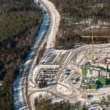What alternatives to nuclear energy?
By Charles Forsberg, October 6, 2011
For those opposed to nuclear energy, the belief is that there are alternative energy sources — a faith in alternatives, ironically, as strong as some of the early advocates for nuclear power in the 1950s. But no such options exist in a world that will soon have 10 billion people (see Forsberg, “Mutually Assured Energy Independence”). That fundamental reality dictates the need for nuclear energy.
Climate change, fossil fuels, and famine. We have fossil fuels; however, the burning of fossil fuels releases carbon dioxide into the atmosphere with the potential for large changes in (1) climate and (2) pH (acidity) of water and soil. Both threaten agricultural productivity, because the changing climate moves agriculture to less productive soils. A consistent climate is critical in the formation of fertile soils — a several-thousand-year process. Climate change also may entail rebuilding much of man’s infrastructure, which is designed for specific climate and sea-level conditions. Betting on fossil fuels is a high-risk strategy for world agriculture and food supplies. While carbon dioxide sequestration will work in a few locations, it’s unlikely to be a universal solution.
Renewables: latitude counts. We live on a globe circling the sun that creates seasons. That reality means that renewable systems must address how to store energy on a daily, weekly, and seasonal basis. It also drives the design of future energy systems.
At MIT, we examined electricity-storage requirements for California assuming three energy futures: (1) all electricity produced by nuclear reactors operating at constant output, (2) all electricity produced by wind assuming California wind conditions and the National Renewable Energy Laboratory (NREL) wind model, and (3) all electricity produced by solar using the NREL solar-trough model that includes limited energy storage. Table 1 shows the fraction of electricity that has to go into storage at times of excess electricity production to provide electricity when demand exceeds supply.
| Hourly | Weekly | |
|---|---|---|
| All Nuclear | 0.07 | 0.04 |
| All Wind | 0.45 | 0.25 |
| All Solar | 0.50 | 0.17 |
The hourly storage requirements were determined by using the hourly demand curves for electricity and the hourly electricity outputs of solar or wind or nuclear in California. The weekly storage requirements assumed that smart grids, pumped storage, and other technologies could result in each week having a uniform electricity demand, but different weeks have different electricity demands. It is thus a measure of the seasonal storage requirements that needs to be identified, assuming different energy sources with seasonal storage requirements measured in 10s to 100s of gigawatts per year depending upon the electricity production technology.
Two-thirds of our electricity is base-load electricity; base-load nuclear energy has low electricity storage requirements. The storage requirements for solar and wind, however, are higher. In fact, the situation is even worse than indicated in Table 1, because the calculations assumed perfect storage systems. Real seasonal storage systems have just 50 percent efficiency but may ultimately increase to 70 percent. In other words, serious wind and solar energy initiatives require massive seasonal storage systems.
There are seasonal energy storage technologies being developed, such as nuclear-geothermal gigawatts per year and hydrogen systems. In a nuclear-geothermal energy storage system at times of low electricity demand, nuclear energy is used to heat a 500-meter cube of rock a kilometer or more underground to create an artificial geothermal heat source for peak power production. However, there is no way to insulate rock a kilometer underground. The heat losses are only a few percent on a large system but prohibitive in smaller systems — that is, it is a technology that only couples to large-scale nuclear energy.
The potentially viable seasonal electricity storage technologies (including hydrogen) either couple to nuclear plants or involve synergistic combinations of nuclear and renewables — but viable storage technologies do not couple efficiently to wind and solar. Renewable advocates point to Denmark and Germany — countries whose wind systems depend upon Scandinavian hydro. However, there is not enough hydro worldwide to make a serious dent in the storage challenge. An all-renewables world will remain unaffordable — even if the cost of renewables drop because of the larger challenge of energy storage to match production with demand.
Conclusions. Our energy challenge requires nuclear and renewables — technologies that are complementary in many applications. Energy is over 10 percent of the global GNP, so economics matters because mankind needs more than energy to prosper. The risks of nuclear energy are small compared with the alternatives of oil wars, climate change, or unaffordable energy.
Topics: Nuclear Energy
Share: [addthis tool="addthis_inline_share_toolbox"]














